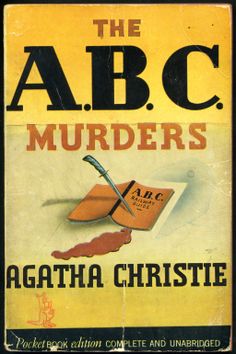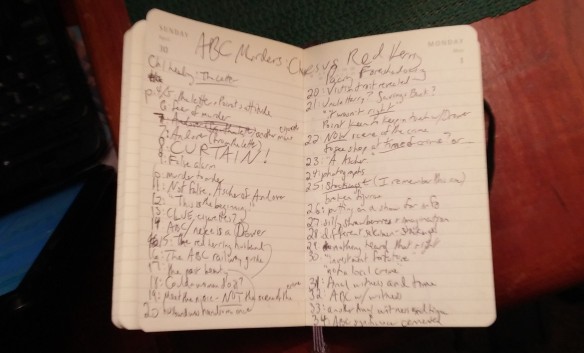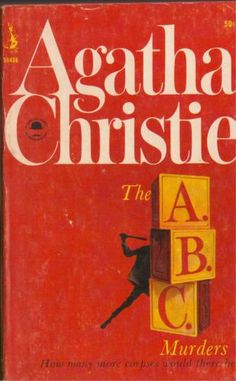 When we think “cozy mystery,” we think of a manor, or someplace isolated, with a limited cast and one, maybe two murders in a tight amount of time. Subtle clues that we didn’t understand come to light when the detective gives his Great Reveal in Act III. My study of The Mysterious Affair at Styles fulfilled such requirements, as do other major Agatha Christie novels, like Murder on the Orient Express, Cat Among the Pigeons, or Murder on the Nile.
When we think “cozy mystery,” we think of a manor, or someplace isolated, with a limited cast and one, maybe two murders in a tight amount of time. Subtle clues that we didn’t understand come to light when the detective gives his Great Reveal in Act III. My study of The Mysterious Affair at Styles fulfilled such requirements, as do other major Agatha Christie novels, like Murder on the Orient Express, Cat Among the Pigeons, or Murder on the Nile.
So let’s not talk about any of those and look at A.B.C. Murders instead.
This particular mystery takes place in and around London. The victims are not known until they’re dead. The killer has no face–in fact, the only clue that connects the murders is an A.B.C. railroad timetable. That’s the mark of a serial killer. The cast morphs and sprawls with each death.
All the while Poirot’s little grey cells ponder over long periods of time.
Now I will admit to my own little crime: I am writing this post before finishing the book. I read it once as a child, but, as suggested by Damien Walter, I wanted to give A.B.C. a serious study for craft’s sake, starting with that all important-topic:
Pacing.
In my earlier study of The Mysterious Affair at Styles, I noted just how quickly Christie gets the story moving in that first chapter with character introductions. I wondered how every line’s got to count in a mystery, be it for the character or the plot. This time, I decided to see what Christie accomplishes on every single page of A.B.C. Slow work, but already I find it most worthwhile.
Rather than give you my notes–well, here’s some of them. Now go and be thankful you don’t see my handwriting on a regular basis.

Chapter 1’s header already engages us: “The Letter.” Consider the book’s title: Are we talking about the letter A? Correspondence was still a primary form of communication–are we talking about a posted letter? By page 4, we find out it’s both: the first note from our killer, taunting Poirot with a murder to be committed in the city of Andover. Hastings, of course, does not take it seriously, but Poirot does. On page 9, the killer’s predicted day comes and goes, and Hastings calls it a false alarm. By page 11, we learn differently. Come page 12, we get one hell of an eerie statement from Poirot:
“This is the beginning.”
Every single page contains a clue of sorts: testimony from a witness/suspect, scene of the crime, Poirot’s critique, and so on. Trust me, I looked for a page that could have been cut for its insignificance. As of nine chapters, we have two murders, two different groups of suspects and witnesses, two different towns, two different inspectors.
On page 24, for instance, Poirot took time to study the only three photographs in a victim’s apartment. You just know that’s going to be useful later, right? On page 25, Hastings tells us what he sees in the apartment; no overlap, and it sounds mundane, and yet in a mystery everything counts, so one of those items just has to stand out sometime.
By page 37, Poirot has met with the first victim’s family and usual suspects, then visited the scene of the crime. At this point, all leads to dead ends, and Poirot tells Hastings that there is nothing that can be “done” until the murderer strikes again. Hastings, being British, loathes this not-doing-anything, and spends page 38 lamenting Poirot’s clear loss of detecting powers. Sounds pointless? Not at all. The page puts doubts in reader’s mind as to whether or not Poirot really can solve this crime. For those who have read from Hastings’ perspective before, we know he’s not a reliable narrator, yet we can’t help but feel our faith shaken.
Then comes page 39, and another letter predicting murder with a B. Christie breezes over weeks of time by distracting us with Hastings’ doubt. From pages 40-42 we get the new victim, the conflict with a new inspector, and the increase in doubt of Poirot’s abilities.
By page 48, we start to see at least one connecting thread between victims thanks to Poirot. No, not the railway guide, that’s the obvious one left by the murder. Poirot remarks on the beauty of both victims. Why? Hastings doesn’t think on it, passing it off as something foreigners do. You’d think Hastings would know better by now…Anyway, that makes nine chapters.
It was as if every couple hundred words Christie took care to stick a useful tidbit in. Maybe she counted, maybe not. But I could certainly see why The New York Times said that this book is “The very best thing Agatha Christie has done”–at least that’s what it says on my edition, a 17th printing (SEVENTEENTH!) from 1967.
tidbit in. Maybe she counted, maybe not. But I could certainly see why The New York Times said that this book is “The very best thing Agatha Christie has done”–at least that’s what it says on my edition, a 17th printing (SEVENTEENTH!) from 1967.
Christie lets no page go to waste. Only one page of genuine reflecting in nine chapters, and not general reflecting, either–it has an underlying agenda. Setting details are given quickly, almost waved aside:
“A dingy little place…A commonplace little shop, one of many thousand such others.” (23)
“Situated on the sea front, this was the usual type of small tea-room. It had little tables covered with orange-checked cloths and basket-work chairs of exceeding discomfort with orange cushions on them.” (45)
Did I mention the one departure from Hastings’ point of view? Chapter 2 focuses on a man named Mr. Alexander Bonaparte Cust? A man in a “shabby bedroom,” who smokes “cheap cigarettes,” and cults a “railway guide” and a “typewritten list of names”? We get this on pages 6-7.
He’s not been mentioned since.
But cheap cigarettes and railway guides sure have.
Such little things, and yet because of this single departure from Hastings we hunt through the little details Christie places on every page, measured and sprinkled like chocolate chips for muffins. Too many and they’ll just spill off and melt on the pan. Too few, and the children will gripe and revolt and demand better muffins. (What, that doesn’t happen in your house?) Measuring out the placing of details gives readers reason to read not just the good chocolatey bits, but the whole thing. Give readers a sweet on every page, and they will not walk away until you’re story’s devoured completely.

Aren’t words a joy? You wrote ‘pacing’ and in that one lonely word you set the scene…you the lecturer; the hall where your audience sit listening; plus said audience! ‘Pacing’…that’s all it took!
LikeLiked by 1 person
(blushes) Thank you, Time Traveler. 🙂 xxx
LikeLiked by 1 person
Good though…what a single word can do. A single word poem, there’s a challenge!
LikeLiked by 1 person
Oh GOSH. Don’t you dare! 😛
LikeLiked by 1 person
Effectively it is what those little pictures on FB serve to do…I think; I don’t know how to use them!
LikeLiked by 1 person
LOL!
LikeLiked by 1 person
While I’m not a mystery lover per se (excluding, ahem, “Midsomer Murders” 🔪!) I appreciate your obvious fascination with this genre. Moreover, it’s fun to see you light up the post with your wit, your confessions (you didn’t read ALL of the book? The horror, the horror! 😱) and your precise pacing analysis.
I also got a kick out of your sharing your handwriting with us. (I’d like to see some pages written after you imbibe three cups of Rocket Fuel!) 🚀☕️
The last paragraph’s chocolate chip analogy….how many superlatives can I possibly use to describe how much I approve of such a comparison? I’ll use only one so you can get on with your day: it is supercalifragilistikexpialidocious !!!!
lots of love to you, my friend, and be on the lookout for another pound of precious ☕️ in the next day or two!
LikeLiked by 1 person
Yowza, you spelled that out!
It hit me this morning I owe you (and me by default) a writer’s music post on the theme from MIDSOMER. Well, it ain’t spooky October, but I think November still fits just fine, don’t you? 🙂
my kids revolt on the chips in muffins ALL THE TIME. Apparently I have to dump the whole bag in before they’re satisfied. It doesn’t help that Biff has gotten surgeon-good at removing the chips and leaving the rest of muffin intact.
Three cups? I’ll take a shot of my handwriting after a pot! 😛
I can’t wait for the next shipment of fuel to send me to infinity…and beyond! (Disney, you owe me five bucks.) 😛
love and hugs to you, Your Java Highness! xxxx
LikeLiked by 1 person
Lol…love the handwriting. Jean a great post. You really draw a reader in with your excellent reflections. Talk about never a word wasted in your write up either xxxxx
LikeLiked by 1 person
Shucks. I bow in gratitude, O Lovely Lady Shey. 🙂 xxxx
LikeLiked by 1 person
Nonsense lovely lady Jean. Take it in your stride xxxxx
LikeLiked by 1 person
I really enjoyed that novel, though I read it quite a long time ago too and don’t remember who the killer is… A muffin is a great metaphor for a novel 🙂
LikeLiked by 2 people
Thank you! It’s hard not to make that connection when I bake them every week for picky eaters. 🙂
LikeLiked by 1 person
Oooh! ooh! I remember the pertinent clue!!! But I won’t spoil it for you 🙂 You really nailed it- she doesn’t waste space in her books, but still manages good descriptions and interesting characters, (even the dead ones 🙂 She just makes them all COUNT. I never really considered it before- thanks! And now I must add more chocolate chips to the bars I’m making…
LikeLiked by 1 person
Mmmmmmm, chocolate chip bars… 😉
Actually, I found a book cover that gives away THE clue from the story, which really irks me. I’ll show it when I write my study on clues and red herrings. 🙂
LikeLike
Booo! Who DOES that? Oooh, that sounds like an interesting study! It’s hard to know what “gives away” too much, without having a conclusion just come out of left field :p
LikeLiked by 1 person
There’s another blog I follow…I gotta hunt her up tomorrow…she does book cover comparisons every week. She even did an Agatha Christie story a few weeks ago! For this post I used the first cover design, and the design for the paperback I own. Yeah, if I’m write about the naughty cover, I’ll be REALLY peeved.
LikeLike
I read that one! (I’ve been using a lot of your fb posts for inspirations:) I wonder sometimes if the people who design covers ever actually READ the books- when I had energy to be irritated by things like that I found many of the covers of my favorite books very irritating because of details that didn’t fit etc.
As to other things going on- Be strong and courageous, friend! You’re not going it alone. hugs!
LikeLiked by 1 person
thanks for following my blog ..😊😊 I have grown up reading Agatha Christie..probably after Nancy drew .. loved this read
LikeLiked by 1 person
Thanks for stopping by! I also did some dissecting of The Mysterious Affair of Styles a few months ago. Hope you like those posts, too!
LikeLiked by 1 person
I LL c them asap
LikeLike
Great post. Makes me want to get my hands on an Agatha Christie book right this minute….and stuff a chocolate muffin in my mouth.
LikeLiked by 1 person
I know, right? I had to bake some after writing this just to silence my tummy. 🙂
LikeLiked by 1 person
Pingback: Lessons Learned from Agatha Christie: Have Mischievous Fun with Misdirection. – Jean Lee's World
I love how you deconstructed the novel. It reminds me of when I would write notes in the margins of books I liked or underline passages that I particularly enjoyed. But what a good idea. I might have to do that myself! Especially since these days I read everything via Kindle.
p.s. found you through Lisa (Passionate Reason). Cheers!
LikeLiked by 1 person
I love Lisa’s site! I must check yours out in the near future.
And thanks for reading–this study was a bit of a challenge for me, so I’m glad I made some sense in the end. 🙂
LikeLiked by 1 person
Great post. I love this book. It’s so contained, so gentle, so brilliantly structured. Completely riveting
LikeLiked by 1 person
It’s a favorite–and never adapted, save for David Suchet’s Poirot! THIS would be the story that could drive a film forward, not Orient Express…
LikeLiked by 1 person
Never liked that book that much for some reason.
LikeLiked by 1 person
It’s all conversation! Yes, the twist is great, but the story itself is aaaaaaaaaaaaaaaaall conversation. After the murder, nothing happens! Everyone talks for a while, and then the story’s done. Blech.
LikeLike
Pingback: My #western #fantasy #novella is #onsalenow for #99cents! Plus, #lessons learned in #worldbuilding for #writing #fantasy #fiction: #AnEasyDeath by @RealCharlaine. | Jean Lee's World